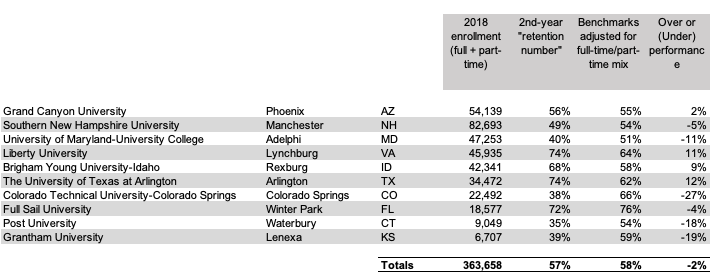Retention in national online programs
The data is bad quality and many of the results are just bad
Inadequate federal reporting from online undergrad programs leave us with poor retention and graduation data in what is an important emerging sector
Some reported levels are so woeful that, even with inadequate metrics, it suggests several national online programs are not viable
What exactly did the University of Arizona acquire in Ashford?
Our second installment on retention - how many entering students return for a second year - will focus on national online colleges. This post is intended more for numbers geeks and those who follow institutional reporting, but it covers an important issue. The proportion of partly or entirely online students was creeping up pre-COVID and surely counts as among the handful of key emerging trends in higher ed. So how are these programs doing in terms of student satisfaction and achievement? It is unclear. The short answer is that we know too little. The summary for readers who want a quick take: “we can’t see anything because of the smoke but, where there’s smoke, there’s fire.”
Terrible quality numbers
The national onlines solely teaching via online classes, excluding those who mix it with in-person, enrolled 217,287 undergrads in 2018. To measure how many students returned for a second year, those schools reported on only 5,570 students, or 2.6% of their enrollment. That 2.6% compares to the 16% US higher ed overall sampled for this metric. 16% meets the sniff test given a typical time to graduation of 6 years for entering undergrad (100% divided by 6 = 17%) but 2.6% is a small slice of the population that should be surveyed.
A reader could sensibly ask, “well, ok, the retention numbers are unclear, but what about the graduation numbers?” Unfortunately, these small sampling sizes also affect published graduation rates based on tracking cohorts from preceding years.
How many entering students return to their online programs for a second year? We don’t know. How many entering students end up graduating from the program in which they first enroll? We don’t know.
Terrible numbers
Being cynical adults, our reaction to seeing numbers that are incomplete is to suspect they are being gamed and that the real results are not as good as portrayed. But what if those incomplete end results themselves are lousy?
Of those 5,570 entering students reported by programs exclusively online, 45% were enrolled in the next fall, far below the national average of 72% for all US higher ed.
The table above includes only exclusively online universities. Major players like UMD Global and Southern New Hampshire of course are partially in-person. That mix of traditional and distance teaching further confuses retention statistics. Looking at national onlines with in-person learning:
This table includes both colleges with a heavy focus on online (UMD Global and SNHU) and those with many in-person classes (Liberty, BYU Idaho). Students sampled to report retention represent only 7% of enrollment. The 2nd-year retention ratio of 61% is better than the online-only schools but lies below the national undergraduate average of 72% and of course includes some in-person students.
(Because it was in the midst of a reporting reorganization, Purdue Global is omitted here.)
Four of the colleges featured in the tables above reported retention numbers under 25%, meaning over three quarters of the entering class did not show up for a second year. For perspective, in our prior report on retention, we cited the University of Alaska-Anchorage’s retention number - 61% of its first years remain registered the next fall - as a sign of crisis. When three quarters of a school’s students withdraw within twelve months, you have to wonder who these enrolled students were, what they were being taught and why so many of them were so dissatisfied with the program.
Of the four, American Intercontinental had the best data quality among these four (7% of students are measured) AND the worst retention ratio (22%), which suggests but doesn’t conclusively show that counting fewer students positively affects retention statistics.
What about the full-time/part-time mix?
This evaluation needs to take into account the fact that national onlines teach more part-time students, because part-time students are far likelier to leave a school than full-time. In 2019, the retention gap was a full 31 points: 76% of full-time students reenrolled at their college from last year, but only 45% of part-timers did. This gap has persisted at similar levels throughout the 2010s.
To better separate the retention impact of online education from that of part-time enrollment, we created a rough proxy benchmark which set a target based on the full-time proportions of the major onlines. The table below shows that the average 2nd-year retention benchmark for the online only group is 67% based on the mix of full- and part-time. First, the online-only schools:
While the small sample sizes continue to be concerning, the underperformance at Columbia Southern and Capella are much less significant. The outperformance of Western Governors conversely is also less impressive, as it is strictly full-time. And yes, that is plus 44% for American Public University.
Moving on to the mixed online/in-person programs, the differences are smaller, as expected.
The benchmark average of 58% shows the larger proportion of part-time students in this group, with only a slight underperformance by the group as a whole. This is a first cut. More focussed study using regional comps is needed for fuller evaluation. For example, UT-Arlington has a very solid +12% retention vs benchmark, but the large Texas schools almost all score above the US retention ratios, indicating that the Texas higher ed ecosystem likely has structural factors encouraging retention. Whatever qualifications are necessary, however, the benchmark comparisons for Colorado Tech, Post and Grantham are concerns.
Arizona Global/Ashford
The full-time/part-time benchmark does not affect Ashford’s numbers as it is wholly full-time. To accelerate its offerings in online education, the University of Arizona acquired Ashford in August 2020, in a deal widely compared to the earlier Purdue/Kaplan merger. Ashford’s retention trends were very negative in the years leading up to the transaction.
Poor retention was naturally affecting the undergraduate program revenues as reported by Zovio, Ashford’s owner. Zovio and its predecessor company did not isolate Ashford undergraduate program revenues in its financial statements so we provide an estimate, an estimate in line with Zovio’s reported overall revenues consolidating undergrad and graduate programs at Ashford and its smaller operation, the University of the Rockies.
Needless to say, Zovio was not a flourishing company. As recently as 2015, Zovio had embarked on a restructuring plan specifically focussed on declining enrollment. The shareholder letter on this restructuring described improving trends, among them a flattening of enrollment declines. The subsequent 2016 shareholder letter makes no mention of the restructuring plan or improvements in the enrollment picture but does criticize existing Department of Education (DoE) metrics for being inapplicable to online students and announces Zovio’s renewed emphasis on student retention, while underlining the quality of the new learning management software system it was implementing and boasting about the excellent survey responses from Ashford graduates about its offerings.
When reading public statements from stumbling companies, it is always a good rule to ignore the puffery and concentrate on the questions that the company was attempting to answer, here from Zovio shareholders and sell-side analysts. Wall Street was concerned about: a) enrollment declines ; b) terrible DoE metrics; c) lousy software systems; d) dissatisfied students. We cannot opine on Ashford’s learning software (comments are open if you have experience with it) but Zovio failed to halt the other ongoing 2016 trends. In fact, its cash burn rate suggested Zovio was about to go out of business when the University of Arizona stepped in. It had $95 million in cash on hand in December 2019 after a year where it had used up $97mm. Eight months later, it was acquired.
Zovio’s deteriorating financial position explains why it entered the transaction, but why did University of Arizona take Ashford into its portfolio? The answer: because there is virtually no economic downside for Arizona. Unlike most acquisitions, it included no cash payment from the acquiring organization and it got a first cut of revenues from Ashford’s future activity. The Phil on Ed Tech blog has a detailled and sourced commentary on the deal well worth reading if you are curious.
While we believe that the deal was much more beneficial for Arizona than for Zovio, for our purposes here, the lesson is that one of the nation’s biggest online colleges was failing in the marketplace and things had got so dire it was acquired for no money in what amounted to a fire sale. Such a marketplace outcome suggests that Ashford’s retention data was an accurate indicator of enrollment problems. This in turn implies that the national online sector’s results, even if based on too-small sample sizes, are indicative of significant student readiness and satisfaction issues.
Whether fully-online undergrad programs are viable is put in doubt by these results. The asterisk here is that the biggest of the programs, Western Governors (WGU), has been reporting very solid retention (73% in 2019), very close to the US industry average. WGU, which is entirely full-time, has a different academic model than the other national onlines: it relies almost entirely on full-time instructors and assigns a large number of staff to student support and planning. If that 73% is representative of WGU’s student body, then its model may represent a real innovation. But the sample WGU used to calculate its retention was the smallest of any the institutions, 0.2% of its undergrad count, making it a less reliable number. If the jury is out on WGU, however, the student results from many of the other national onlines are below average and indicate future problems for big online education.
American Public University stats presented without comment
American Public, the West-Virginia-based online university that enrolls about 38,000 mostly part-time undergrads, has been reporting big improvements in retention. We will end the post by presenting its numbers along with the US average (which of course includes 4-year programs) without comment.
Update (Mar 23): Coincidentally, Zovio announced that Andrew Clark, their long-time CEO, was leaving the company the day after this post appeared.











